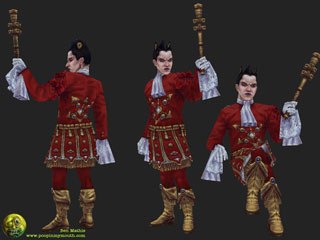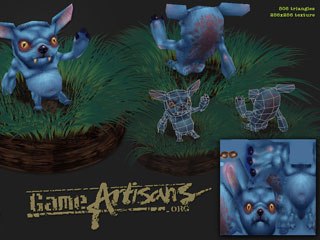Fred Galpern catches up with Ben Mathis to find out more about his career after recently leading the GDC Visual Arts Track on Maxon BodyPaint.
There were many highlights during this year's Game Developer's Conference. Some attendees would point to particular games, others to the inevitable future of overwhelming amounts of downloadable content. The more seasoned GDC goer would be more likely to point out the obscure, perhaps smaller talk, that while well-attended, did not offer a superstar headline but did reward with solid content, information that could be put to use back home in the studio. These talks are harder to find each year at GDC as the conference evolves with the industry. While we may never again see the days where the bulk of the GDC talks are nuts and bolts type production discussions, we can count on a handful of artists to give those valuable talks when the occasion arises and also to continue to educate through their own websites and online tutorials. One of these rare breed of teaching artists is Ben Mathis.
The first thing you need to know about Mathis is that he is impossibly young. Age in this case is simply a measure, one that might be used to estimate a person's contribution to his chosen field. In Mathis' case, age not only doesn't tell the story it barely starts it off. At age 26, he has contributed artwork to 10 published games, many of them yet-to-be-announced titles, all for numerous development studios and game publishers. This is a track record that most developers twice his age would be proud of. To Mathis' credit he maintains a genuine "Aw shucks, I'm just doing what I love to do" attitude. I had the pleasure to talk with Mathis at this year's GDC, immediately following his presentation about Maxon's BodyPaint software.

Fred Galpern: Why don't you start off by giving the VFXWorld readers some background about yourself.
Ben Mathis: I've been working in the game industry since 2003. I've contributed to 10 shipped titles, and worked for numerous studios both in-house and remote. I specialize in creating characters, animals, weapons and vehicles, for any generation of system. I also create training material and pipeline enhancement.
FG: What role do you enjoy most on a team? In particular, how do you find yourself contributing to the more technical parts of game art?
BM: I enjoy coming up with new tools and processes, and then sharing them with the rest of my team. When possible, I also enjoy showing those results to the rest of the world, so that the videogame industry as a whole can benefit and move forward with better art. I'm a fast worker, knowledgeable and constantly learning, as well as experienced."
FG: Reach back to early in your career, which was only a mere few years ago, and talk about how you got started making games and how that early experience has led you to your current role with the Eve Online developer, CCP, in Reykjavik.
BM: My first job came rather interestingly. I was going to school for 3D animation, and found out that I really didn't like animating at all. I experimented around with a few other art-related subjects, but it wasn't until I decided to do a publicly available art test for a game studio that I knew what I wanted to do. As soon as I finished making those first two low poly characters, I knew for sure that's what I wanted to do for a living. That semester I switched my major, and started looking for summer internships. However, one of the places I applied to was looking for a full-time junior artist. I emailed them on a Tuesday, and by Thursday I was flying to Texas to interview, and Friday I got the job offer. The following Tuesday I was in a rented U-Haul driving to Texas for my first job. Not only was that aspect a whirlwind, but pretty much everything since has been too. That would explain why I'm living in Reykjavik, Iceland!
FG: Please explain how you came to digital art, and games, in particular. Was it a little bit differently than the usual path taken by artists in game development?
BM: Unlike most people in this industry, I had no artistic aspirations as a kid. I was largely unchallenged in most areas, but did enjoy tinkering and learning new things. It wasn't until senior year of high-school that I took any interest in drawing, and that was halfway through the year. I remember enjoying a lot of artistic mediums, just not ever realizing that there were people behind those products.
FG: What was the first piece of software you used? Was it a recent version of 3ds Max or Maya? Did it help you find a shortcut to where you are today?
BM: I bought a copy of Ray Dream 3D out of a CD bin at a thrift store. This was right around the advent of CD-ROMs. I would scour the CD drawer for CDs that were ROMs rather than music, and if they were interesting looking, I'd pay the $1.50. I scored Ray Dream 3D for $1.50 with the serial written on the lid. No help file, so I had to figure it out entirely myself. This was when I was about 14 or 15, and while I figured out enough to make a robot arm, I kind of forgot about it and didn't explore it at the time. Now I really wish I could have gotten those seven years of practicing in.
FG: Any favorites from the trenches of production?
BM: Well, just recently I was able to create a toy prototype for McFarlane toys for the Halo 3 toyline. It was probably one of the most challenging modeling projects, because not only did the model need to be water tight, it also had to be detailed enough to make the toy. I've never gone that detailed on a model before. The most fun project I've ever worked on was for Neversoft on Gun. I was only there for the final three months, but it was really a blast working on Wild West characters on a team that organized. Finally, I have to mention making the secret character for Tony Hawk 8, which is a large man sized voodoo doll with crooked button eyes that are about a foot across. That was a blast and kind of strange.
FG: Tell us some of the horror stories that are part of the lore of the industry.
BM: I don't want to get in trouble with this story, so I'm going to keep it generic. On one project we had to crunch for three months leading up to GDC, then had a month off, and went right back into a six month crunch for the final game. By crunch, I mean 80+ hour weeks. I was a zombie just a few weeks in. I rode my bicycle to work at the time, and there were days when I don't even remember the ride -- I did it entirely on autopilot -- and I still wonder to this day if I obeyed traffic lights or if I almost was killed several times on the ride to work.
FG: What are your favorite tools of the trade?
BM: Favorite would be BodyPaint. I can just disappear while texturing, and BodyPaint has really let me get into the painting aspect. Least favorite would be ZBrush, because I can never seem to get the controlled brush strokes that some of the masters have.
FG: Tell us about the games and other modern entertainment that are on your personal radar at the moment.
BM: I was really impressed by the morally ambiguous choices in The Witcher. I'm so used to the super transparent "this is the good choice, the neutral choice and the bad choice" in RPGs. In The Witcher, they were very ambiguous as to their outcomes, so I actually had to think, "Stop guessing what the choices will mean in the game, and do what you, Ben Mathis, would do if you were there." It made it so much more fun for me. Film-wise I loved the look of 300, and I'm really getting into the art direction of some of my favorite photographers as well.
See more of Ben Mathis' work, as well as some excellent tutorials put together by Mathis.
Fred Galpern is currently a game producer at Blue Fang Games, located just outside Boston. He is also a co-creator of the game development program at Bristol Community College. Since entering the digital art field more than 12 years ago, Galpern has held management positions in several game and entertainment companies, including Hasbro and Looking Glass Studios. He began his art career in comic books and also has interactive, print and web design experience.












